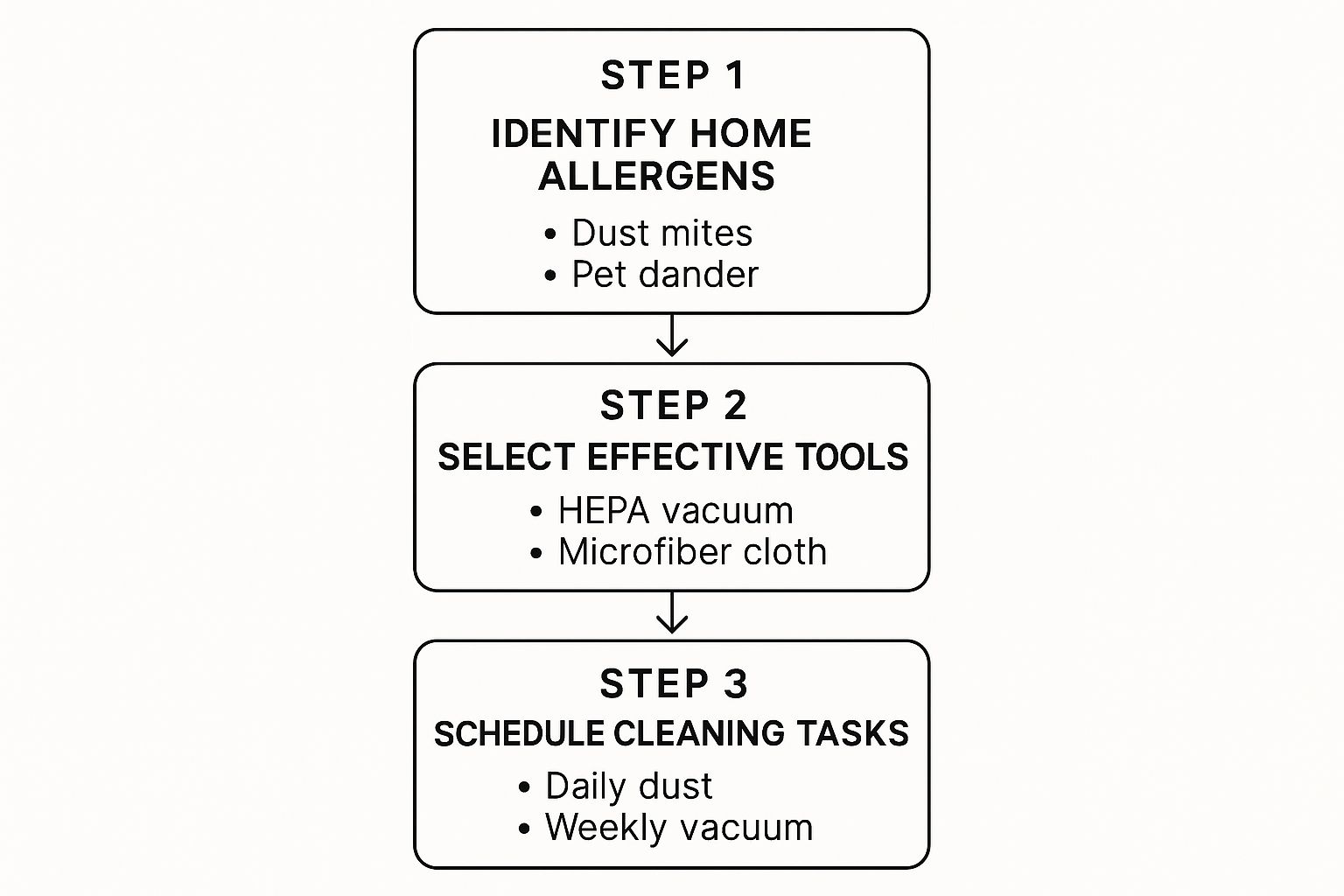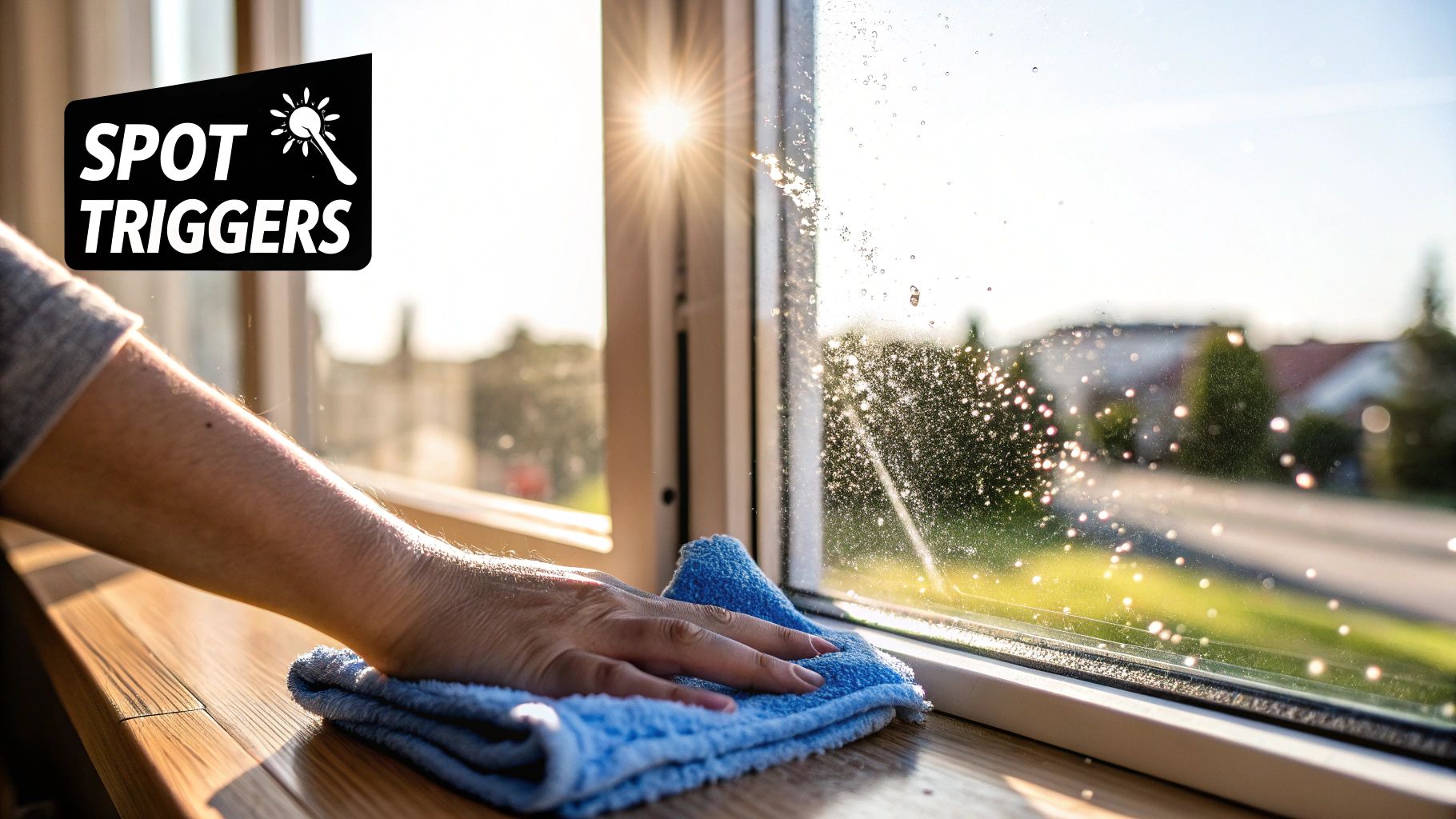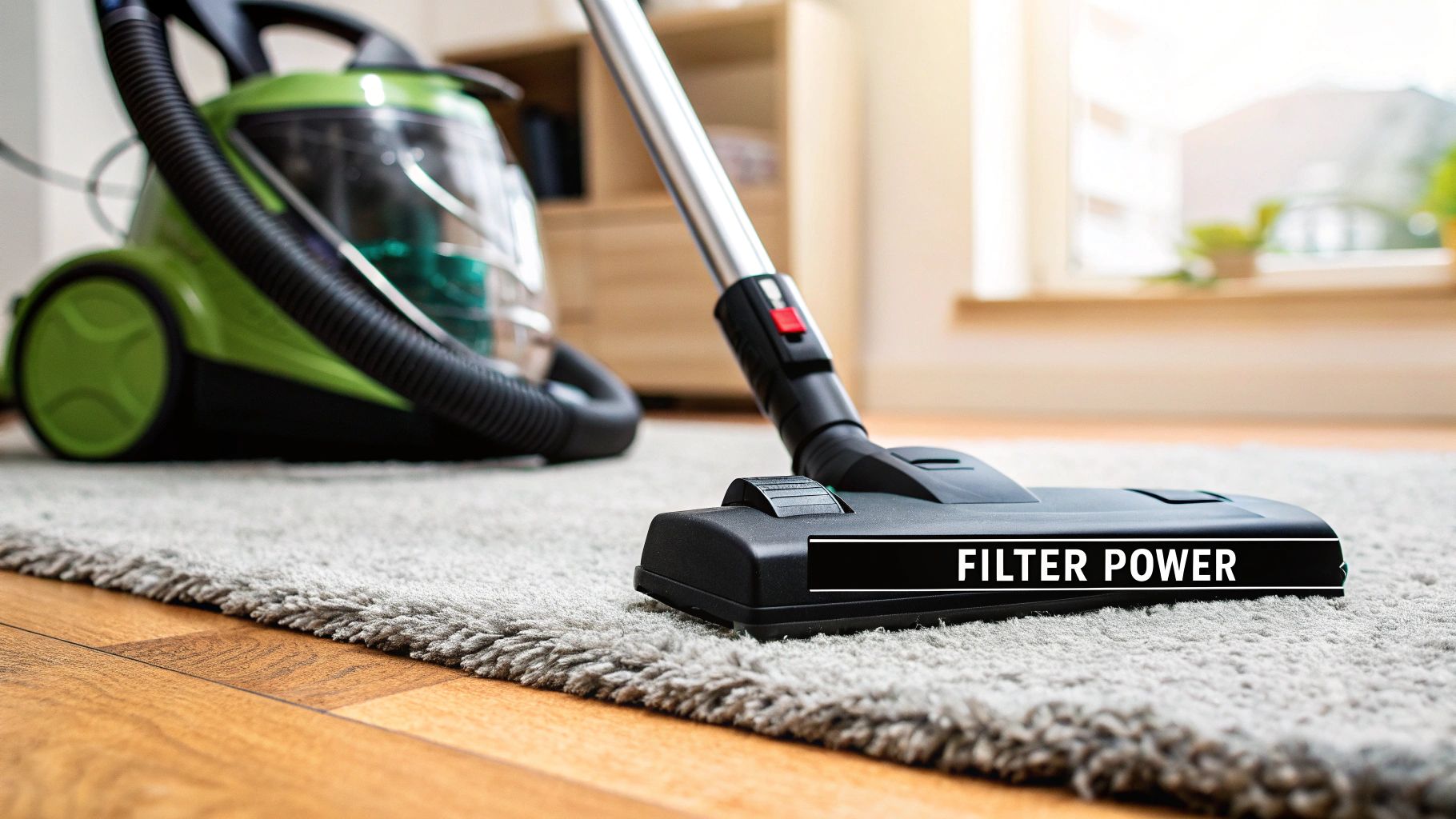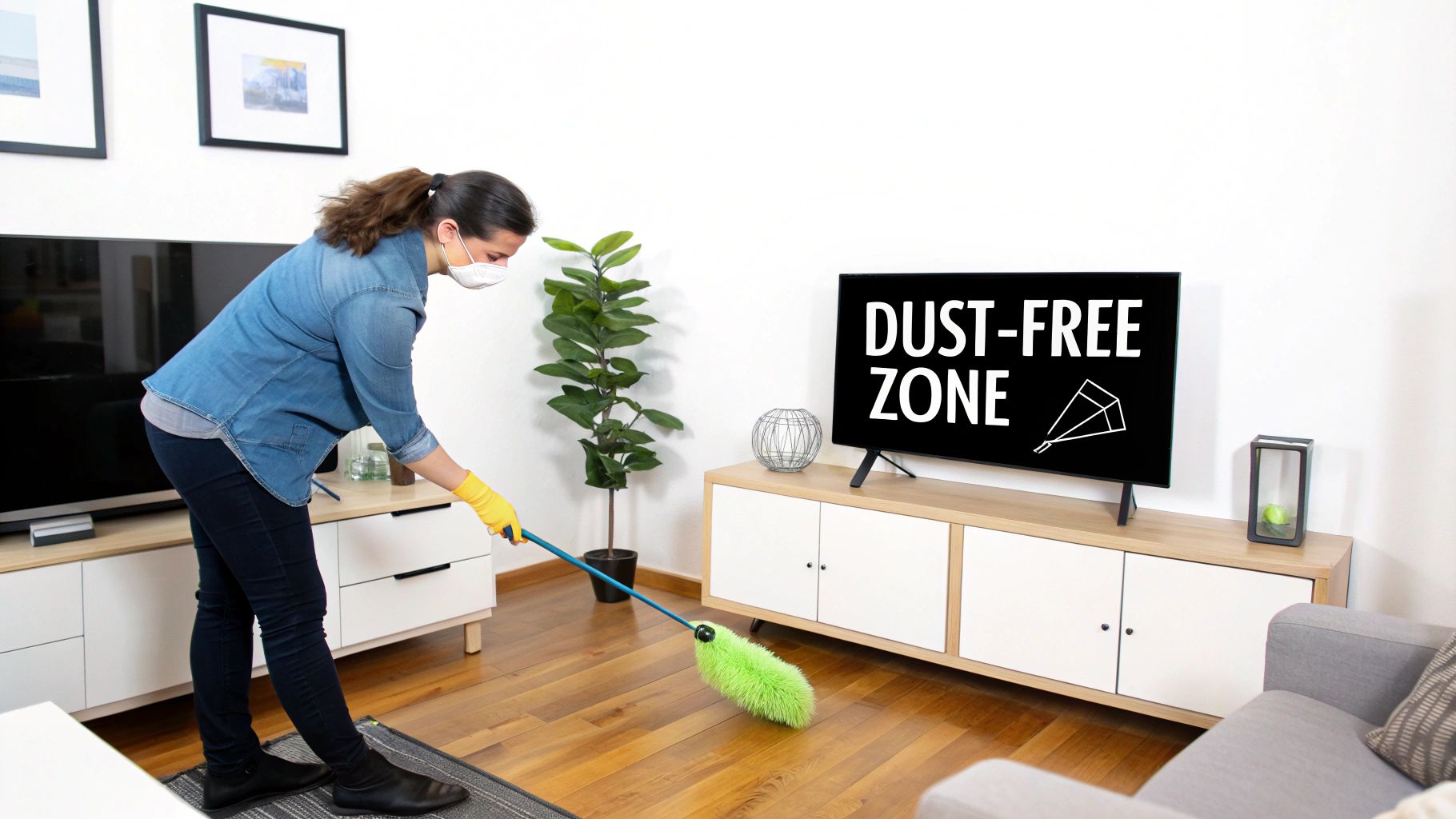If you're tired of constant sneezing, itchy eyes, and a stuffy nose being your normal at home, it's time for a change. Effective cleaning for allergies isn't just about tidying up; it's a strategic attack on the triggers that make you miserable, like dust mites, pet dander, and pollen. This targeted approach is the single most powerful way to create a healthier home and find real, lasting relief.
Your Action Plan for an Allergy-Proof Home
Think of an allergy-focused cleaning plan as disrupting the life cycle of allergens, not just wiping them off surfaces. It’s a proactive strategy that improves your home's air quality and cuts down on symptoms right at the source. This is about cleaning smarter, not necessarily more, by hitting the high-impact areas where allergens love to hide.
This approach is more important than ever. The global market for allergy treatments is booming, projected to hit nearly $33.21 billion by 2029. That number shows a huge shift in awareness—more people realize that what’s in their home environment directly affects their health. You can read the full research on the allergy treatment market to see just how big this trend is.
Building Your Allergen-Reducing Schedule
A consistent schedule is your secret weapon for managing household allergens. Some tasks need daily attention, while others are fine for a weekly or monthly deep clean. The goal is to create a routine you can actually stick with, one that stops allergens from building up without feeling like a full-time job.
This simple workflow shows how to get started.

As you can see, a winning routine starts with pinpointing your specific triggers, grabbing the right tools, and then sticking to a schedule.
A successful cleaning routine is your first line of defense. By physically removing allergens, you reduce your daily exposure and lessen the burden on your immune system, often providing more immediate relief than medications alone.
A well-planned schedule takes all the guesswork out of it. You’ll know exactly what to tackle and when, making sure every bit of effort leads to a healthier, more comfortable home. This framework helps you focus on what really moves the needle for allergy relief.
Transform Your Bedroom into an Allergy Sanctuary

Given that you spend about a third of your life in the bedroom, it’s not surprising that it's ground zero for allergens. Dust mites, in particular, absolutely love the warm, cozy environment of our beds, mattresses, and pillows. To really get a handle on allergies, you have to treat this room as your top priority.
The bed itself is the main offender. A single mattress can be home to millions of dust mites feasting on dead skin cells. The first and most effective line of defense is creating a physical barrier between you and these microscopic intruders.
This is where allergen-proof encasements for your mattress and pillows become non-negotiable. These zippered covers are woven so tightly that dust mites and their waste can’t get through, which immediately cuts down on what you’re breathing in all night.
Tackle Bedding and Mattresses Head-On
Washing your bedding is a crucial step, but the details make all the difference. To actually kill dust mites, you need to wash your sheets, blankets, and pillowcases in water that’s at least 130°F (54.4°C). Check your washing machine for a "hot" or "sanitize" setting to make sure you’re hitting that temperature.
Make this a weekly ritual. If you have pets that share the bed, you might even need to do it more often to keep pet dander under control.
Beyond the linens, your mattress needs some attention too. Once a month, strip the bed completely and vacuum the mattress surface. Use the upholstery attachment to get right into the seams and crevices where dust and allergens love to accumulate. It’s a simple step that makes a huge impact.
Pro Tip: After stripping the sheets, let your mattress air out for at least an hour before making the bed with fresh linens. This helps reduce moisture, making the environment far less inviting for dust mites.
Declutter and Choose Flooring Wisely
Allergens will settle on any surface they can find. Clutter, from stacks of books to decorative knick-knacks, just gives dust more places to hide. A more minimalist approach doesn't just look cleaner; it makes your cleaning routine far more effective. For a streamlined strategy, our guide on how to clean a bedroom fast offers practical tips that work perfectly with an allergy-focused plan.
Your choice of flooring also plays a massive role. Carpets are essentially giant sponges for allergens, trapping dust, dander, and pollen deep in their fibers. No matter how often you vacuum, it's nearly impossible to get it all out.
If you have the option, go for hard-surface flooring like hardwood, laminate, or vinyl. These surfaces are so much easier to keep clean and prevent allergens from building up. If you're stuck with carpet, make sure it’s a low-pile style and vacuum at least twice a week with a HEPA-filter vacuum.
Conquer Allergens in Living Rooms and High-Traffic Areas

Your living room, family room, and hallways are the command center of your home. They're where pet dander from the dog's favorite spot on the couch collides with the pollen you track in on your shoes. This constant mix of indoor and outdoor triggers makes these high-traffic areas ground zero for your allergy-fighting routine.
The soft surfaces in these spaces—especially your upholstered furniture and area rugs—are the biggest culprits. Think of your sofa not just as a place to relax, but as a giant fabric trap for dust, dander, and all the other microscopic particles that leave you sniffling and sneezing. A methodical approach is the only way to keep these spots from becoming an allergy hotspot.
Deep Cleaning Upholstery and Soft Surfaces
Your regular vacuum is a good start, but when you’re serious about cleaning for allergies, a model with a HEPA filter is non-negotiable. It’s designed to capture 99.97% of particles as small as 0.3 microns. That includes the vast majority of common allergens that a standard vacuum would just spit back into the air.
To really get after your couch or armchair, you need to use the vacuum’s attachments:
- The upholstery tool: This wide-mouthed attachment is perfect for covering the large surfaces of cushions and the sofa back.
- The crevice tool: Use this to dig deep into the seams and under cushions, where crumbs, pet hair, and dust mites love to hide.
I recommend making this targeted vacuuming a weekly habit, especially if you have pets. It pulls out embedded allergens before they have a chance to build up and cause problems.
Tackling allergens has become a huge focus for homeowners and businesses. The global cleaning services market is on track to hit $468.2 billion by 2025, a jump driven by a new awareness of how cleanliness impacts our health. This growth shows a clear demand for services that get rid of allergens effectively. You can discover more insights about cleaning industry trends here.
Mastering Dust and Airborne Particles
Let's be honest, old-fashioned feather dusters often do more harm than good by just flicking dust into the air. The real goal is to capture particles, not just relocate them. The best way I’ve found is to use a damp microfiber cloth. The moisture and the cloth's tiny fibers work together to trap and hold onto dust for good.
Always start dusting from the highest surfaces in the room and work your way down. It's a simple trick, but it ensures that any particles you miss will fall onto surfaces you haven't cleaned yet, like the floor, which you'll vacuum last.
Finally, you have to address the allergens you can’t even see. Good ventilation helps cycle out that stale, allergen-filled air. On days with low pollen counts, I try to open the windows for at least 15-20 minutes. For around-the-clock support, consider adding an air purifier with a HEPA filter to your living room. It works 24/7 to capture airborne particles, giving you an extra layer of defense against allergy triggers.
Tackling Mold and Moisture in Kitchens and Bathrooms

Kitchens and bathrooms are notorious hotspots for allergens. The constant humidity creates the perfect breeding ground for mold and mildew, two of the most potent triggers for allergy sufferers. To win this battle, you need a specific game plan that focuses on controlling moisture and targeted cleaning.
The first line of defense against mold is cutting off its life source: moisture. This means making it a non-negotiable habit to run the bathroom exhaust fan during every single shower and for at least 15-20 minutes after. No fan? No problem. Cracking a window open can do the trick. This simple step prevents steam from settling on your walls, ceiling, and fixtures, stopping mold before it even starts.
Pinpointing and Cleaning Hidden Mold
Mold is sneaky. It loves to grow in the dark, damp places you don't look at every day, so a regular inspection is your best friend for catching it early.
Be sure to check these common hiding spots:
- Under the Sinks: Both kitchen and bathroom sinks are prone to slow, unnoticed leaks that create a mold paradise.
- Around Faucets and Drains: The constant dampness makes these areas prime real estate for mildew.
- Shower Curtains and Liners: Those plastic or fabric folds are a classic spot for that gross pink or black mildew to appear.
- Refrigerator Drip Pans: This is a component most people forget exists. It collects condensation and can quickly turn into a science experiment if ignored.
When you do find mold, don't just wipe it away. Attack it with an effective cleaning solution. A simple mix of vinegar and water often works wonders, as do store-bought mold and mildew removers. The key is to scrub the area thoroughly and then dry it completely to keep it from coming right back.
Key Takeaway: Proactive moisture management is far more effective than reactive cleaning. By keeping surfaces dry and improving ventilation, you eliminate the conditions mold needs to grow. This makes your cleaning efforts much more successful in the long run.
Beyond mold, kitchens have their own set of allergen issues. Food crumbs and spills are an open invitation for pests, and their droppings are a very common allergy trigger. Wiping down your counters daily, sweeping up messes as they happen, and taking out the trash regularly can make a huge difference.
Dealing with these high-moisture zones can feel like a never-ending chore, but building small, consistent habits into your routine is the most effective approach. For a more detailed guide on staying ahead of the problem, you can learn more about how to prevent bathroom mold and keep your home healthier. This consistent effort ensures these problem areas stay safe and symptom-free.
Choosing the Right Tools for Allergy Cleaning
Your cleaning methods are only half the story when you're fighting allergies at home. The tools you use are just as critical. Picking the right gear isn't just about cleaning faster; it’s about choosing equipment that actually traps and removes allergens, not just stirs them up into the air. Get this part right, and you'll feel the difference.
Investing in your allergy-cleaning toolkit is a powerful part of a complete allergy management strategy. While medical treatments are always improving, experts agree that what you do at home matters immensely. In fact, the market for allergy immunotherapy is expected to climb to USD 5 billion by 2035, which shows just how serious the effort is to combat allergic reactions. You can read more about the evolving allergy immunotherapy market to see how science is tackling the problem. Your cleaning tools work hand-in-hand with these advancements by reducing the daily allergen load you’re exposed to.
The Non-Negotiable HEPA Vacuum
If you make only one change to your cleaning arsenal, make it this: get a vacuum with a true HEPA filter. HEPA stands for High-Efficiency Particulate Air, and these filters are absolute game-changers. They’re designed to capture 99.97% of particles as tiny as 0.3 microns. We’re talking about the worst offenders—dust mite droppings, pet dander, pollen, and mold spores—that a standard vacuum just spits right back out.
When you're shopping, look for vacuums with a sealed system. This is a key feature that many people overlook. It ensures that all the air sucked into the machine passes through the HEPA filter before it's released. Without it, allergen-filled air leaks out from the cracks and seams of the vacuum body, defeating the purpose.
Pro Tip: Don't neglect the attachments! A good crevice tool and an upholstery brush are your secret weapons for pulling allergens out of tight corners, furniture seams, and along baseboards where they love to hide.
Comparison of Essential Allergy Cleaning Tools
To make sure your cleaning routine is as effective as possible, it helps to have the right tools on hand. Here's a quick comparison of the must-haves for an allergy-friendly home.
| Tool | Key Feature for Allergies | Best For | Pro Tip |
|---|---|---|---|
| HEPA Vacuum | Traps 99.97% of microscopic particles like dander and pollen. | Carpets, rugs, hard floors, and upholstery. | Choose a model with a sealed system to prevent allergens from leaking back into the air. |
| Microfiber Cloths | Electrostatic charge attracts and holds onto dust. | Dusting surfaces, wiping down walls, and cleaning blinds. | Use them slightly damp to capture even more dust and prevent it from becoming airborne. |
| Steam Cleaner | Kills dust mites and denatures allergens with high heat. | Hard surfaces, tile, grout, and sanitizing mattresses. | Ensure the surface is heat-safe before using. Avoid on unsealed wood or delicate fabrics. |
| Air Purifier | HEPA filter continuously removes airborne allergens. | Bedrooms and main living areas where you spend the most time. | Run it 24/7 during high-pollen season for the best results. Change filters on schedule. |
Having this combination of tools means you can tackle allergens on every surface, from the floor to the air you breathe, creating a much more comfortable environment.
Microfiber: The Allergen Magnet
It’s time to toss out those old feather dusters and cotton rags. For dusting, microfiber cloths are your best friend, hands down. The fibers are incredibly fine and carry a natural electrostatic charge, which means they act like a magnet for dust particles, trapping them instead of just pushing them around.
For the best results, use them slightly damp. The moisture helps grab onto every last speck of dust and dander, ensuring nothing escapes back into the air. This one simple swap can make a huge difference in the air quality while you clean. For a full breakdown of top-performers, check out our guide on the 13 cleaning tools people absolutely rave about.
Smart Cleaning Solutions
The cleaning products you choose are just as important as your tools. Many popular cleaners are loaded with harsh chemicals and strong fragrances that can easily irritate a sensitive respiratory system, potentially making allergy symptoms even worse.
Fortunately, you have some great, safe options:
- Certified Products: Look for cleaning supplies that have been certified by organizations that test for irritants and allergens. This takes the guesswork out of shopping.
- DIY Solutions: You don’t need fancy chemicals to get a good clean. A simple mix of white vinegar and water makes an excellent all-purpose cleaner that disinfects without harsh fumes. For scrubbing, a paste made from baking soda and water works wonders on surfaces without scratching them.
By making smart choices with your tools and cleaners, you transform your cleaning routine from a basic chore into a powerful way to improve your health, creating a safer and more comfortable home for everyone.
Got Questions About Allergy Cleaning? We've Got Answers
Even with the best intentions, diving into a new cleaning routine for allergies can bring up a lot of questions. It's easy to feel a little lost. Let's clear up some of the most common things people ask so you can clean with confidence and finally get some relief.
How Often Should I Really Be Cleaning?
This is the big one, and the honest answer is: it depends on your triggers and how bad your allergies are. A good starting point for most people is a thorough deep clean once a week. That means hitting all the essentials—vacuuming with a HEPA filter, dusting surfaces with a damp microfiber cloth, and washing your bedding in hot water.
However, some tasks demand a bit more attention to keep allergens from building back up:
- Daily: A quick wipe-down of kitchen counters, tables, and other high-traffic surfaces can make a big difference. If you have pets, a daily vacuum of the main living area is non-negotiable for controlling dander.
- Weekly: This is your core cleaning day. Get a thorough dusting in, vacuum all the floors and upholstered furniture, and give the bathrooms a good scrub.
- Monthly: Think bigger. This is the time to wash curtains, vacuum your mattress, and pull furniture out to clean behind it.
The real secret? Consistency. If you only clean sporadically, allergens just have time to settle back in. A steady routine is what keeps them at bay for good.
Expert Tip: An air purifier is a fantastic tool, but it's part of a team—it's not a substitute for cleaning. It works 24/7 to pull dander, pollen, and other gunk out of the air. But it can't lift allergens that have already settled on your couch or carpet. Think of it this way: your vacuum and dust cloth remove the settled dust, and the purifier grabs what’s still floating around.
Are "Natural" Cleaning Products Actually Strong Enough?
Absolutely. In fact, many natural or "green" cleaning products are not only effective against allergens but also have a huge advantage: they don't contain the harsh chemicals or strong perfumes that can trigger respiratory issues all on their own. Simple staples like vinegar and baking soda are powerhouses for cutting through grime and getting rid of odors without making you sneeze.
When it comes to pets, your best defense is a multi-pronged attack. Grooming your pet regularly (ideally outside) is the first step to reduce how much fur and dander even makes it into your home. Follow that up with weekly vacuuming of all your furniture and frequent washing of pet beds and blankets.
Here’s a great trick for stubborn pet hair: use a rubber-bladed squeegee or even a damp rubber glove to pull hair off fabric before you vacuum. It works like a charm.
Are you ready to create an allergy-friendly home without all the hard work? The team at Custom Maids has been providing meticulous, professional cleaning services since 1982. Let us handle the dusting, vacuuming, and deep cleaning so you can breathe easier. Get your free, customized cleaning consultation from Custom Maids today!

